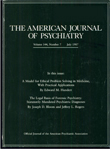Fluoxetine and norfluoxetine plasma concentrations in major depression: a multicenter study
Abstract
OBJECTIVE: Prior studies examining the relationship between fluoxetine plasma concentrations and response in major depression have either found no relationship between plasma concentration and response or suggested a curvilinear relationship with a therapeutic window. To elucidate this relationship, plasma concentrations of fluoxetine, norfluoxetine, fluoxetine plus norfluoxetine, and fluoxetine/norfluoxetine ratio were compared to therapeutic response. METHOD: A total of 839 patients (577 women, 262 men; mean age = 40 [SD = 11] with a DSM-III-R diagnosis of major affective disorder who were in the course of either depression or bipolar disorder not otherwise specified and had a minimum baseline score of 16 on the 17-item Hamilton Depression Rating Scale were initially treated. Response was defined as follows: 1) nonresponders had less that a 50% or more reduction from baseline Hamilton depression score, 2) nonremitting responders had a 50% or more reduction from baseline Hamilton depression score but a final score higher than 7, and 3) remitters had a final Hamilton Depression score of 7 or lower. Plasma fluoxetine and norfluoxetine concentrations were measured after 8 weeks of fixed-dose treatment of 20 mg/day. RESULTS: Plasma concentration data were available from 615 patients. Plasma concentration were similar in responders, both remitting and nonremitting (N = 411), and nonresponders (N = 204) for fluoxetine concentrations, for norfluoxetine concentrations, as well as for the sum of fluoxetine and norfluoxetine and for the ratio of fluoxetine to norfluoxetine. No apparent relationship was observed between plasma drug concentration and clinical response. CONCLUSION: Plasma concentrations of fluoxetine and norfluoxetine do not appear to be related to clinical outcome and should not be used to make treatment decisions.



